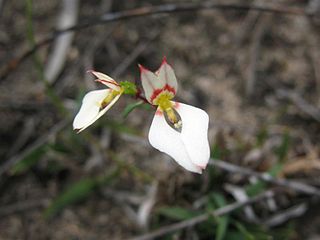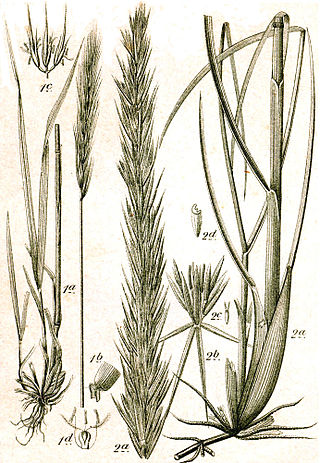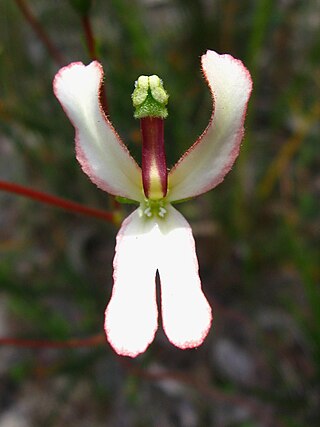
Stylidium is a genus of dicotyledonous plants that belong to the family Stylidiaceae. The genus name Stylidium is derived from the Greek στύλος or stylos, which refers to the distinctive reproductive structure that its flowers possess. Pollination is achieved through the use of the sensitive "trigger", which comprises the male and female reproductive organs fused into a floral column that snaps forward quickly in response to touch, harmlessly covering the insect in pollen. Most of the approximately 300 species are only found in Australia, making it the fifth largest genus in that country. Triggerplants are considered to be protocarnivorous or carnivorous because the glandular trichomes that cover the scape and flower can trap, kill, and digest small insects with protease enzymes produced by the plant. Recent research has raised questions as to the status of protocarnivory within Stylidium.

Microsorum is a genus of ferns in the family Polypodiaceae, subfamily Microsoroideae, according to the Pteridophyte Phylogeny Group classification of 2016 (PPG I). The species are tropical. Like most ferns, they grow from rhizomes, rather than roots. The genus name is often misspelled "Microsorium" or "Microsoreum". It includes some species that are lithophytic rheophytes.
Stylidium tenellum is a dicotyledonous plant that belongs to the genus Stylidium. It is an annual plant that grows from 5 to 27 cm tall. The obovate or elliptical leaves, about 6-14 per plant, are scattered along the elongate, glabrous stem and are generally 3.5-8.5 mm long and 0.8-2.5 mm wide. Scapes are absent. Inflorescences are 2–8 cm long and produce white, pink, or mauve flowers that bloom from September to December in their native range. S. tenellum is endemic to Southeast Asia and its distribution ranges from southern India to southern China and south to Sumatra. In China it's known from Guangdong, Yunnan, and southern Fujian provinces. Its habitat is recorded as being seasonal swamps and is often reported to grow near rice paddies. It is usually found growing at low altitudes but has been recorded from elevations as high as 1100 metres on Sumatra. S. tenellum is most closely related to S. diffusum.
Stylidium kunthii is a dicotyledonous plant that belongs to the genus Stylidium and is one of the few species in the genus that is not native to Australia. It is an erect annual plant that grows from 8 to 20 cm tall. Obovate, orbicular, or obleanceolate leaves, about 5-15 per plant, form terminal rosettes with some scattered along the stems. The leaves are generally 4–15 mm long and 2–9 mm wide. This species generally has one to five scapes and cymose inflorescences that are 5–14 cm long. Flowers are white or pink. S. kunthii has a wide distribution in Southeast Asia, ranging from eastern India to Myanmar, Bengal, and Vietnam. Its typical habitats include the wet soils of rice fields, natural grasslands, and road cuttings at an altitude of less than 200 metres. It flowers from November to December. S. kunthii is most closely related to S. uliginosum, but differs by the cauline leaves.

Stylidium graminifolium, the grass triggerplant, is a dicotyledonous plant that belongs to the genus Stylidium. This species used to belong to the Stylidium graminifolium complex, but the name was conserved for this single species when two others were split from the complex and introduced as new species in 2001. S. graminifolium is endemic to Australia and is one of the Stylidium species with the widest distribution throughout Australia. It is a perennial plant with grass-like leaves and is easily cultivated. It has been considered to be a carnivorous or protocarnivorous plant because it possesses glandular trichomes underneath the flowers that can trap and digest prey.

Andersonia is a subgenus of Stylidium that is characterized by a linear hypanthium, recurved mature capsule walls, an erect and persistent septum, and many seeds. This subgenus occurs in areas of tropical northern Australia and into Southeast Asia and was named in honour of William Anderson, the surgeon and naturalist who sailed with James Cook.
Stylidium tenerrimum is a dicotyledonous plant that belongs to the genus Stylidium. It is an erect annual plant that grows from 4 to 30 cm tall. Linear, oblanceolate, or deltate leaves, about 5-24 per plant, are scattered along the stems. The leaves are generally 1.2-4.8 mm long and 0.3-0.8 mm wide. This species lacks a scape but has cymose inflorescences that are 4–11 cm long. Flowers are white and red. S. tenerrimum is found around Darwin in the Northern Territory of Australia and the Victoria River, though it hasn't been recollected there since the type location was chosen. Its typical habitat is sandy soils that remain moist, associated with grasses and sedges. It flowers in the southern hemisphere from April to August. S. tenerrimum is most closely related to S. alsinoides, though it differs by its asymmetrical petals. In his revision of the subgenus Andersonia in 2000, A.R. Bean placed S. evolutum into synonymy and noted that the type specimen of S. mitrasacmoides was not located and thus the application of this synonym is not certain. Tony Bean assessed this species' conservation status as data deficient in 2000.
Stylidium lobuliflorum is a dicotyledonous plant, with a native range is concentrated in and around Kimberley in Western Australia and extends to the Northern Territory.
Stylidium schizanthum is a dicotyledonous plant that belongs to the genus Stylidium that was described by Ferdinand von Mueller in 1859. It is an erect annual plant that grows from 9 to 30 cm tall. Obovate, orbicular, or oblanceolate leaves, about 3-13 per plant, form basal rosettes. The leaves are generally 3.5–23 mm long and 1.5–12 mm wide. This species generally has one to four scapes and cymose inflorescences that are 9–30 cm long. Flowers are white, pink, mauve, or yellow. S. scizanthum's distribution ranges from the Kimberley region in Western Australia through the Northern Territory and into northern Queensland. It has been reported as far south as Mount Surprise and even in southern New Guinea. Its typical habitats are moist sand in Eucalyptus or Melaleuca communities, near creekbanks, or associated with sandstone landscapes. It flowers in the southern hemisphere from February to October. S. schizanthum is closely related to both S. pachyrrhizum and S. lobuliflorum.

Stylidium tenerum, the swamp triggerplant, is a dicotyledonous plant that belongs to the genus Stylidium that was described by Curt Polycarp Joachim Sprengel in 1826. Robert Brown had described this species in 1810 under the name S. tenellum, a name which had already been used for another species in 1805 by Olof Swartz. To add to the confusion, Rica Erickson had described and illustrated this taxon in 1958 under the name S. uliginosum, another currently accepted name for a related species.

Levenhookia, also known as the styleworts, is a genus of ten recognized species in the family Stylidiaceae and is endemic to Australia. The genus is restricted to Western Australia almost exclusively with a few exceptions: L. pusilla's range extends into South Australia, L. dubia's range extends through South Australia into Victoria and New South Wales, L. sonderi is native only to Victoria, and L. chippendalei is also found in the Northern Territory.

Eremopyrum is a genus Eurasian and North African plants in the grass family. One species, Eremopyrum triticeum has become widely established as a weed in parts of North America.

Heteranthelium is a genus of Asian plants in the grass family. The only known species is Heteranthelium piliferum, native to Central Asia, Afghanistan, Pakistan, Iran, Middle East, Turkey, and the Caucasus.
Stylidium exappendiculatum is a species of dicotyledonous plant in the genus Stylidium.

Stylidium squamosotuberosum is a species of plant in the genus Stylidium. It was described in 1969 by Sherwin Carlquist. Discovered in 1969.
Stylidium arenicola is a species of dicotyledon plant in the genus Stylidium. It was described in 1969 by Sherwin Carlquist.

Stylidium schoenoides is a species of dicotyledon plant of the Stylidium genus, from Stylidiaceae family, Asterales order, first described by Augustin Pyramus de Candolle in 1839. The plant is endemic to Western Australia.

Polytrichum piliferum, the bristly haircap, is an evergreen perennial species of moss in the family Polytrichaceae. The bristly haircap moss is small-sized to medium-sized and forms loose tufts with wine-reddish stems. It is an acrocarpous moss that appears bluish-green to grey. This moss grows in clumps on erect shoots and becomes a red-brown colour as it grows older. The most distinguishing feature of P. piliferum is the long, white awn at the tips of the leaves, which also give this moss its grey colour. It is the only species in its genus where the awn is completely hyaline.










